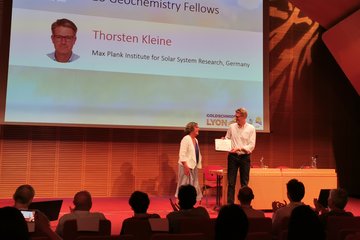Alle Typen
821.
Vortrag
Examination of historical spectroheliogram archives. Space climate symposium 6, Levi, Finland (2016)
822.
Vortrag
The potential of historical spectroheliograms for Sun-climate studies. 9th IAGA - ICMA/IAMAS - ROSMIC/VarSITI/SCOSTEP workshop on long-term changes and trends in the atmosphere, Kühlungsborn, Germany (2016)
823.
Vortrag
Exploring historical Ca II K spectroheliogram archives. XIVth Hvar astrophysical colloquium, Hvar, Croatia (2016)
824.
Vortrag
Non-linear re-calibration of group sunspot number series back to 1739. AGU Fall Meeting, San Francisco, USA (2016)
825.
Vortrag
Reconstructions of past solar irradiance. International Space Climate Symposium-6, Levi, Finland (2016)
826.
Vortrag
Anomalous counter Evershed flows: HINODE observations and MHD simulations. IAU Symposium 327: Fine structure and dynamics of the solar atmosphere, Cartagena de Indias, Colombia (2016)
827.
Vortrag
Solar Spectral Irradiance Reconstruction on Millennial Timescale. 1st Swiss SCOSTEP workshop, Bern, Switzerland (2016)
828.
Vortrag
Reconstructions of Solar Irradiance on the Millennial Timescale. European space weather week 13, Oostende, Belgium (2016)
829.
Vortrag
Why do measurements and models of UV SSI variability not agree? 9th IAGA - ICMA/IAMAS - ROSMIC/VarSITI/SCOSTEP workshop on Long-Term Changes and Trends in the Atmosphere, Kühlungsborn, Germany (2016)
830.
Vortrag
UV SSI variability Why do measurements and models not agree? 6th International HEPPA-SOLARIS Workshop, Helsinki, Finland (2016)
831.
Vortrag
Exploiting historical Ca II K spectroheliogram archives: preliminary results from four archives. Coimbra Solar Physics Meeting, Coimbra, Portugal (2015)
832.
Vortrag
METIS Coronagraph A System Engineering Approach. 66th International Astronautical Congress, Jerusalem, Israel (2015)
833.
Vortrag
SUNRISE Mission Highlights. DPG-Frühjahrstagung, Wuppertal, Germany (2015)
834.
Vortrag
Solar brightness variability in the stellar context. Second SOLARNET Meeting on "Solar and stellar magnetic activity, Palermo, Italy (2015)
835.
Vortrag
Brightness variations of the Sun and Sun-like stars. Solar-Stellar Connection Workshop, Sandbjerg, Denmark (2015)
836.
Vortrag
Modelling stellar brightness variations. Stellar and Planetary dynamos, Göttingen, Germany (2015)
837.
Vortrag
The Maunder minimum: A reassessment from multiple dataset. XXIX IAU General Assembly, Honolulu, USA (2015)
838.
Vortrag
Measurements and models of solar irradiance variability in the satellite-era. Conference on Sun-Climate Connections, Kiel, Germany (2015)
839.
Vortrag
Measurements and models of solar irradiance variability in the satellite-era. Conference on Sun-Climate Connections, Kiel, Germany (2015)
840.
Vortrag
Solar irradiance variability since 1978 Reconciling measurements and models. AOGS 12th Annual Meeting, Singapore (2015)











